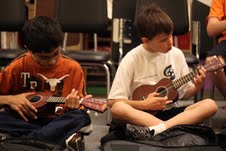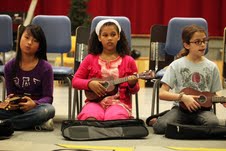Student Artwork Inspired by Hubbard Street Dance Chicago
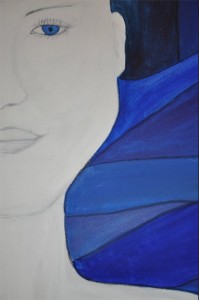
Meredith Giltner, teacher at Carpenter Elementary (our DTE School of the Year!) shared this artwork with us, created by her students in response to Hubbard Street Dance Chicago’s school day performances.
Educator Conversations: Brooklyn Rider
Editor’s note: This post is a part of a series of conversations between educators in the K-12 community. Educators will offer suggestions and answer questions about integrating UMS School Day Performances or the arts into classroom curriculum, as well as share advice on organizing a field trip to UMS. To volunteer to be a Teacher Lobby Moderator e-mail umsyouth@umich.edu. See other Educator Conversations here.
This week’s questions:
- What does “Brooklyn Rider” mean?
- How does a group like Brooklyn Rider learn to play different genres of music convincingly?
- What are some tips for listening to string quartet music?
This week’s moderator: Emily Barkakati is an Ann Arbor-based violinist, community educator, and teaching artist.
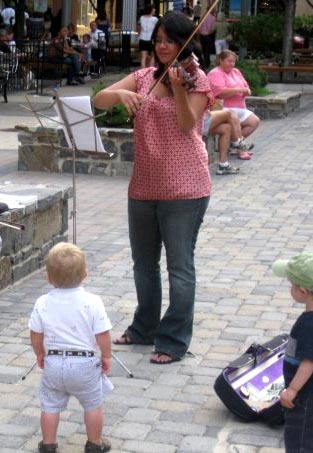 Emily is an Ann Arbor-based violinist, community educator, and teaching artist. She plays with the Michigan Opera Theatre and the Ann Arbor Symphony, organizes events for the Medical Arts Program, runs workshops, and teaches kids how to coordinate their finger hands with their bow arms. She loves crafting, cooking, and learning, and spends a lot of time with her husband and their emotionally dysfunctional cat.
Emily is an Ann Arbor-based violinist, community educator, and teaching artist. She plays with the Michigan Opera Theatre and the Ann Arbor Symphony, organizes events for the Medical Arts Program, runs workshops, and teaches kids how to coordinate their finger hands with their bow arms. She loves crafting, cooking, and learning, and spends a lot of time with her husband and their emotionally dysfunctional cat.
Q: What does “Brooklyn Rider” mean?
Brooklyn Rider’s name is a combination of inspiration from Der Blau Reiter (The Blue Rider) and the borough of Brooklyn in New York City. Der Blau Reiter was a pre WWI Munich-based artistic collective with members such as artist Vassily Kandinsky and composer Arnold Schoenberg. Brooklyn is the place the quartet considers home. The name “Brooklyn Rider” is meant to represent the collaborative spirit of eclectic art-making, both similar to what was found in Der Blau Reiter and in the rich cultural array found in Brooklyn, New York.
Whether it’s the title of a book, work of art, piece of music, or even historical event, there is often a lot that can be derived from something’s name. One of the many ways that students can explore this idea is through the analysis of their own names. For instance:
- What is the etymology of your first name? What about your last name?
- Were you named after anyone?
- Is there a cultural significance to your name? For instance, my last name “Barkakati” comes from my Assamese heritage, and I’ve been told by older relatives that based on traditional Indian naming conventions, our family would have historically been writers.
- Is there a nickname you prefer to go by? What do you think makes it a better representation of your personality?
- What if you could change your name? What would you pick and why?
Students can then use these questions to explore and gain ownership over their personal identities. This kind of exercise could also be expanded into an artistic activity, such as creating a work of art to represent one’s name.
Q: How does a group like Brooklyn Rider learn to play different genres of music convincingly?
Although I can’t speak for Brooklyn Rider, in my own experience I am a predominantly classically trained musician who only started dabbling with improvisation and cross-genre work only in the past few years. The first step I took in my preparation was to simply listen to a lot of music. This is a similar process to learning to write in different styles. Reading a wide variety of genres and authors expands your vocabulary and stylistic knowledge. In the same way, listening to a wide variety of music expands your aural vocabulary. That way when you start playing, you might not know the technical adjustments to achieve the correct sound, but you at least have a mental sound to strive toward.
For me, the most difficult part of jumping into new genres of music was getting over the fear of making mistakes. When I began learning to improvise, a friend of mine gave me the following tips to help me get comfortable:
- Pick a song that you know well.
- Play along with a recording of the song by ear.
- Play along with the recording again, but this time start adding some embellishments.
- Write down some new melodies that would fit into the song. Try playing them on top of the recording.
- Start making up some new melodies on the spot when playing with the recording.
- Remember that there is no such thing as a wrong note! If you play a note that sounds wrong, just turn it into a grace note or an embellishment.
It was important for me to build from my preexisting knowledge in order to gain confidence in my abilities. It also helped tremendously that I had friends who created a safe environment for me to experiment and to receive constructive feedback. The same process of building knowledge in stages, also known as scaffolding, is useful for learning any new genre.
Q: What are some tips for listening to string quartet music?
The key to listening to unfamiliar string quartet music, or any type of complex music, is active listening (as opposed to passive listening). One of the joys of complex music is that there are so many layers – you can listen to a piece many times in many different ways, and always find new exciting elements. At the same time, these many layers are exactly what can also make complex music seem overwhelming. Although different people have different approaches, the key for me is to remain open-minded and allow myself to react in the moment to what is happening. Below are some of the things I think about when listening to unfamiliar music for the first time.
- What are some adjectives that come to mind on my first hearing of the piece?
- Are there any particular melodies that stick out to me? Did I hear them more than once?
- Did the piece remind me of anything that I’ve heard before? Did it invoke any memories or mental images?
- What did I like the most about the piece?
- Is there anything about the piece that I found confusing? What about it was confusing? What are some ways that I can try approaching that section differently to better understand it?
While some believe that it is necessary to research new music in advance in order to understand it, I do not think that this is always the case. I usually prefer to explore my impressions first and then research after. This way my reactions to the piece aren’t influenced by pre-existing interpretations. However, keep in mind that this is just one of many ways to explore new music.
What do you think? Share your responses or questions in the comments section below.
UMS TalkOut Project: Hubbard Street Dance Chicago
Editor’s note: This post is a part of a series. View all TalkOut events.
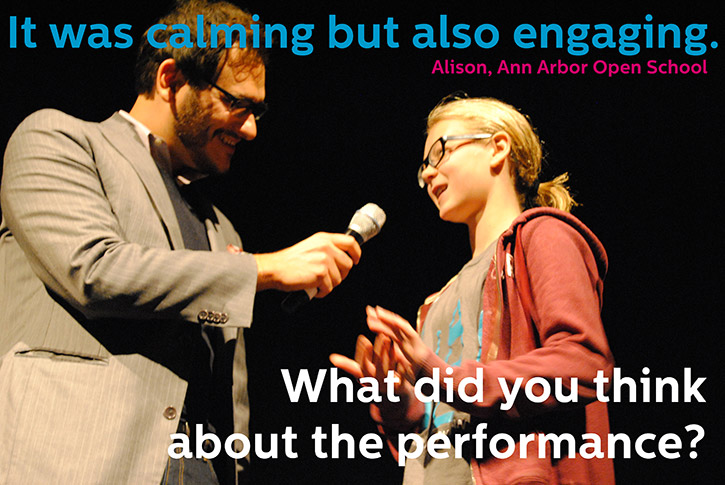
Photo: Alison McCarthy from the Ann Arbor Open School (6th Grade) shares her thoughts.
Our TalkOut project for K-12 students involves speaking and listening (two core K-12 learning competencies) and creating a sharing ripple that allows the experience of a UMS School Day Performance to live on in the minds and hearts of young people and that helps students make connections between the arts on stage and their classroom.
This “TRIMTAB” pilot project was developed with guidance from Eric Booth at the Kennedy Center Partners in Education Program’s February 2013 Annual Meeting by the Michigan 1997 Team: Ann Arbor Public Schools (Robin Bailey), UMS (Jim Leija and Omari Rush), and the Washtenaw Intermediate School District (Jennifer Scott-Burton).
TalkOut encompasses the entire UMS School Day Performance experience. Prior to the start of the show an onstage host provides the entire audience with a framing question. At the end of the performance, two students (selected by UMS and school teachers pre-performance) are invited on stage to share their thoughts and ideas with the entire audience. The feedback is immediately celebrated, captured with photos and audio, and passed on to others for shared reflection.
Here, Lindsay Zinbarg (Saline High School, 12th Grade) participates in TalkOut at the Hubbard Street Dance Chicago performance (interviewed on stage by UMS’s Jim Leija):
Interested in learning more? Download the TalkOut Project Description
Educator Conversations: Ukulele Orchestra of Great Britain
Editor’s note: This post is a part of a series of conversations between educators in the K-12 community. Educators will offer suggestions and answer questions about integrating UMS School Day Performances or the arts into classroom curriculum, as well as share advice on organizing a field trip to UMS. To volunteer to be a Teacher Lobby Moderator e-mail umsyouth@umich.edu. See other Educator Conversations here.
This week, our moderator answers frequently asked questions about teaching ukulele:
- Why ukulele?
- How did you purchase a class set of ukuleles?
- What kind of strings do you use?
- Do you let students take instruments home?
- What do you learn?
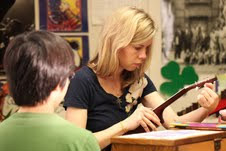 This week’s moderator: Katie Ryan. Katie is a proud graduate of the University of Michigan and Loyola University of New Orleans. Katie began teaching music in the Ann Arbor Public Schools in 1997 and her musical upbringing included experiences in piano, choir, madrigals, concert band, jazz band, musical theater, rehearsal and concert accompanying. She loves bringing a variety of musical experiences to her students at Angell Elementary School in Ann Arbor, Michigan, and hopes that their musical development will help them become life long enthusiasts of music.
This week’s moderator: Katie Ryan. Katie is a proud graduate of the University of Michigan and Loyola University of New Orleans. Katie began teaching music in the Ann Arbor Public Schools in 1997 and her musical upbringing included experiences in piano, choir, madrigals, concert band, jazz band, musical theater, rehearsal and concert accompanying. She loves bringing a variety of musical experiences to her students at Angell Elementary School in Ann Arbor, Michigan, and hopes that their musical development will help them become life long enthusiasts of music.
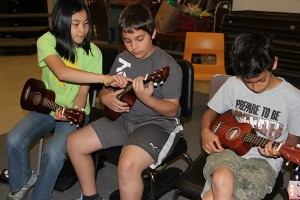
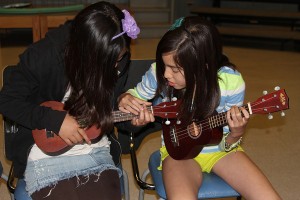
Photos: Students play ukueleles in Katie’s class.
Q: Why ukulele?
A: I’ve always enjoyed teaching recorder to students in third and fourth grades at my school. Because I work with many multi-age classes, I teach this unit every other year so I do not repeat units for students. For many children, the application of musical skills to instrument playing is extremely enjoyable. It’s satisfying for all to see everything come together in this process. In 2011, the Scientific American magazine published a series of articles about the exciting new research linking brain development in young people to experience playing instruments. Not all connections are understood at this point in time, but clearly this experience is powerful for young minds, even in ways that are not immediately evident.
I considered how wonderful it would be for students to have experience playing instruments over three years of their elementary school career, two years with me in vocal/general music and one year in our fifth grade instrumental music program. I reflected back to my own experiences playing ukulele in elementary school. I did research and found this is a common experience for students in Canada and the United Kingdom. I loved the idea that the soprano ukulele is the perfect size for students and that students can sing while playing it. The instrument is capable of playing melodies or chords, which is exciting. Teaching ukulele would lend a better opportunity to teach chord structure, harmonic progressions and form. I also considered that not all of my students will play in band/orchestra or sing in choir when they leave my school, but perhaps they might find some pleasure in playing the ukulele and this is may become a musical outlet for them as they go about their lives after elementary school.
Q: How did you purchase a class set of ukuleles?
A: I visited many of the local music stores in here in Ann Arbor, Michigan. I asked a lot of questions about sound quality and durability. I wanted something that would be a high quality instrument, produce a lovely sound and would hold up to multiple players. Because I planned to buy 25 + instruments, the music store offered a bulk discount, which helped bring down the cost significantly. I spoke with the store about thanking them in our school newsletters and my plans to direct families to them if students chose to purchase an instrument of their own. I believe our community patronized their business quite a bit, especially around the holidays.
After researching how much money I would need, I began looking for grants. Luckily, I live in a community where we have organizations such as the Ann Arbor Educational Foundation. It is an extremely generous organization. I wrote a grant for the instruments as well as soft-sided cases in which to store the instruments to protect the investment. The grant was approved and I was able to purchase most of the instruments. Our school PTO sponsored the purchase of the remaining instruments. I am extremely fortunate.
If you don’t live in a community that has an organization such as these, I’ve had many colleagues and friends recommend organizations such as Donor’s Choose and Adopt a Classroom. See these websites for more information:
http://www.adoptaclassroom.org/
Q: What kind of strings do you use?
A: The folks at my local music store recommended Aquila synthetic strings. They produce a warm tone and are easy to play. They have held up well to use by multiple players. The strings are color coded to make changing strings less challenging.
Q: Do you let students take instruments home?
A: No. Because I have multiple classes using the instruments, I’ve decided instruments must remain at school. I have opened my room up to students who wish to play more often during lunch times. I also structure the classes so that all students have an opportunity to practice/play/discover while I am working with individual students on tuning.
Q: What do you learn?
A: The unit was very successful. “Ukulele fever” was rampant across the school and I am definitely excited to teach the unit again next year. Currently, I will hold a ukulele lunch club for those who would like to continue playing this year. I learned a lot in the process:
I learned students would need to build up calluses, so I incorporated lots of breaks and “air ukulele” playing into our routines as students built up resilience in their finger tips.
Unlike recorders, ukuleles need to be tuned! I learned taking some time to help students with tuning at the beginning of class periods gives others an opportunity to practice. Usually, I would tune the instruments for the first group of students using the instruments in any given day. Classes following would be tuned on a “as needed” basis. Although I had to move quickly, this brief one on one interaction with students was a good relationship builder and something we don’t get to experience often enough when we see hundreds of students per day. Discussion often centered on if strings sounded too high or too low and the new G7 chord, but sports teams, pets, loose teeth and weekend plans were discussed as well, however briefly. I’ve found students are willing to work hard when they know you care about them.
I learned many songs can be sung/played with only two or three chords. There are lots of lists of songs and chords used for ukulele playing floating on the internet. My students became fairly fluent at playing chords used in C Major: C M, F M, G7 and a minor.
I learned how good it is to talk with students about the challenge of doing something new that does not come easily at first. Switching from one chord to the next requires an incredible amount of anticipation, planning, coordination and determination. Many students may feel frustrated at first. I find it’s important to acknowledge this and that learning in general can be hard work. As students find success, it’s all the sweeter.
Please feel free to contact me if you have any further questions! Happy strumming!
Do you have questions or comments for Katie or about teaching through ukuleles? Share your responses or questions in the comments section below.
New! Educator Conversations
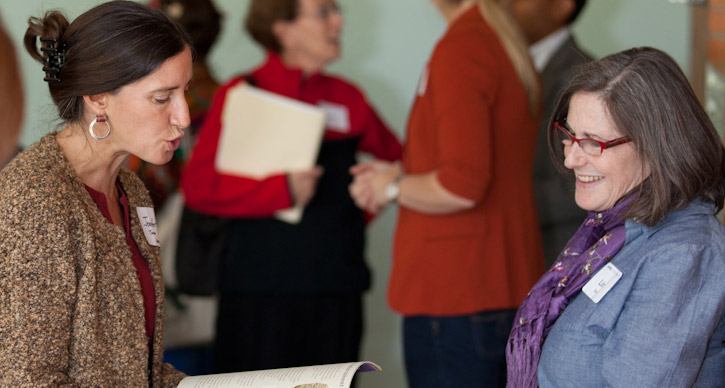
Photo: Emerson School educator Jennifer Tanau and UMS Advisory Committee member Linda Spector at a UMS reception for teachers. Photo by Mark Gjukich Photography.
This season, look for Educator Conversations on UMS Lobby.
Educators will offer suggestions and answer questions about integrating UMS School Day Performances or the arts into classroom curriculum, as well as share advice on organizing a field trip to UMS. To volunteer to be a Teacher Lobby Moderator e-mail umsyouth@umich.edu.
Educator Conversations will take place around UMS School Day Performances. As soon as the conversations are live, we’ll include a link on this page.
- Hubbard Street Dance Chicago with Melissa Poli (Performance September 27)
- Ukulele Orchestra of Great Britain with Katie Ryan (Performance November 12)
- Brooklyn Rider with Emily Barkakati (Performance November 25)
- One Night in Bamako with Jeff Gaynor (Performance February 7)
- Compagnie Käfig with Dianne Dudley (Performance February 13)
- Pedrito Martinez Group with Dan Tolly (Performance March 14)
- Jazz at Lincoln Center Orchestra with Wynton Marsalis with Linda Jones (Performance March 31)
Share you questions or comments below.


